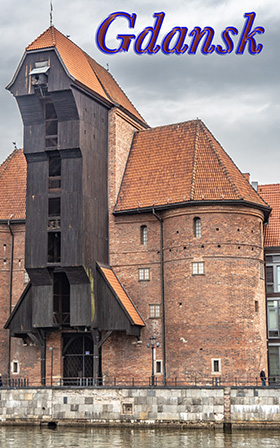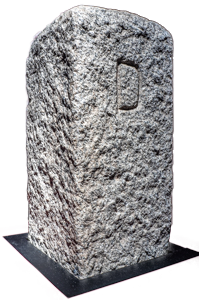


|
Gdansk, Poland's major sea port and an important tourist destination is situated on the Baltic Sea. Its once thriving ship building industry has declined. Buidings in the historic old town remind me of Amsterdam. Extensively damaged in World War II it was rebuilt in the 1950s and 60s. The previous German character was deliberately diluted in favour of French and Dutch influences. Gdansk is the only Polish city that has working carillons. Amethyst is an important industry in the city. |
During my visit I spent most of my time in the Historical Old Town only venturing out to visit the Church of St Nicholas, Museum of World War II and Gdynia Beach.
My unofficial self guided walking tour of the Old Town began at Stągwie Mleczne. The Stągwie Mleczne, Milk Sheds in English, was originally built to store dairy products. Following the road, over the bridge, lead to the Green Gate.
Crossing the bridge towards the Green Gate, looking leftwards, the medieval crane can be seen. Built between 1442 and 1444 the Gdansk Crane was used for moving cargo and raising ship masts. Using only human muscle for power it could lift 4 tonnes to a height of 11 meters. The muscle power was provided by men who stepped on a device looking like a mobile stair case. Remaining in use until the mid 19th century it was eighty percent destroyed in the WWII Battle of Gdansk and rebuilt after the war.

Passing under the archway of the Green Gate bought me to the Długi Targ. Bounded by the Green Gate and the Golden Gate, this area once the city market, is now the most popular part of the historical old town
About midway is Neptune's Fountain, constructed in 1617 to a design by Abraham van den Blocke. The statue was cast in Augsburg and the surrounding fence was added in 1634.
The Town Hall was originally built in 1327-1336. After a fire in 1556 it was rebuilt and expanded. In 1561 a gilded statue of King Sigismund II Augustus was placed on the top of the tower and a 14 bell carillon was placed in the tower. As it did not have a keyboard, today it would be regarded as a chime. The current carillon consisting of 37 bells dates from 2000.
Returning in the direction of the Green Gate, if you turn left at the first street before or after the Town Hall you will come to St Mary's Church.
St Mary's is one of the three churches I visited in Gdansk. Located in the old town, it is one of the largest brick churches in the world. Used for both Catholic and Lutheran services from 1536 to 1572, it was a Lutheran church from the 16th century until 1945. Maybe that is the reason the interior decor is fairly sparse. Currently it is a Catholic church.
Not far from St. Mary's Church is Mariacka Lane which is noted for its amethyst stores., Employing 30,000 people, amethyst, fossilised tree sap, is an important industry in Gdansk.
The old town has many street musicians playing and seeking donations. They are often found in archways near the water front.
The Tower Clock Museum is a museum featuring clock mechanisms. It is located, since the 14th century, in the bell tower of St Catherine's Church.

For centuries most clocks were installed in the towers of large buildings such as churches, town halls and forts. Often the mechanisms were expensive, one ofs, and difficult to maintain.
If you wish to see it you will have to climb 66 steps to reach the ticket office, Climbing the total of 258 steps will take you to the top of the tower for fine views over Gdansk including St Mary's Church.
Also present in the tower is a 49 bell carillon. Dating from 1989 is replaced an earlier one destroyed during World War II. Initially it had 37 bells and a automatic play facility. In 1998 a further 12 bells were added and a complete mechanical action system was installed enabling manual playing from a traditional keyboard. It is now the greatest concert-carillon in Central and Eastern Europe.
The World's first pulser clock was installed in St Catherine's Church in 2011. These use the radio emissions from pulsers, a highly magnetized rotating neutron star, to keep time.
The Church of St Nicholas is about three kilometers outside of the old town. It can be reached by taking the tram and getting off at Opera Baltycka 01.
A Gothic church, it is claimed by some to be the oldest in Gdansk. Others claim St Catherine's Church is the oldest. Initially erected by the Dominicans in 1227, the current church dates from the 14th century. A Renaissance altar was installed in 1647. The interior is of Baroque and Rocco design with many black and gold decorations and paintings with scenes from Jesus's life.
At the back, opposite to the altar, is the beautiful Baroque organ.
St Nicholas was chosen as patron Saint for the church partly because he was the patron Saint for sailors and partly because he is also a Saint that is acknowledge by the Orthodox Church. The church was not damaged during World War II. An Orthodox church I have visted with the same patron Saint was the Greek Orthodox Church of St Nicholas in Sulina, Romania.
The Museum of the Second World War was opened for the public on March 23, 2017.

Having a second war world museum seems appropriate as WWII started here with Hitler’s invasion of the nearby Westerplatte Peninsula.
Construction began in 2015 and its exhibits were open to the public on the 23rd March, 2017.
The museum building consists of three sections, the underground, a plaza and a 40.5 meter tower angled at 45 degrees. The sections are symbols for the past, present and future.
A museum of war, it puts greater emphasis on the impact of the war on people and the city scape rather than military battles.
One exhibit is a recreation/photo of a pure-war shopping street, another ruined building surrounding a Soviet tank.
Before leaving Gdansk and travelling inland, I felt I had to at least have a look at the Baltic Sea. The plan was to take the local tram to Gdynia Beach. As I arrived at the platform an old Soviet tram trundled by in the opposite direction. A hand written timetable said trams ran every 20 minutes. Twenty minutes pass, no tram. It was Saturday. Another 20 minutes passed, still no tram. With patience I waited another hour, before concluding the tram drivers were on strike. So I left the platform walking through an underpass.
Emerging from the underpass, on the other side, there they were, bright shiny new trams leaving for Gdynia every 10 minutes or so. Sometimes I really should do more research!
It is a nice sandy beach. Not many people were present on what was a dull, overcast and slightly chilly day. However when the weather is right I suspect it would be extremely popular.
When I first came to Gdansk I did not know what to expect. All I knew about it was that it is near the mouth of the Vistula River, it was the birth place of Solidarity and in the past it was called Danzig Free City.
By the time I left it was my favourite city in Poland.